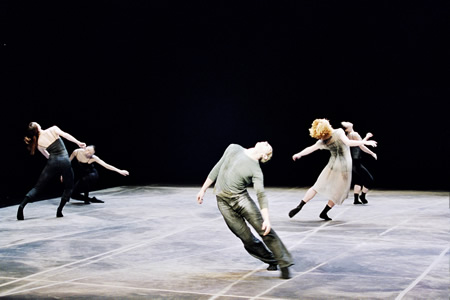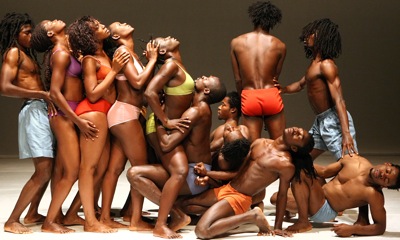Can pagans on a stage make pagans of the viewers? What happens when a percussive and intense style is matched with irregular rhythms and instruments pushed to the brink of their capabilities? Igor Stravinky’s revival of an ancient blood rite produced the primordial happening of the century…. It was not a ballet with a happily ever after ending: a celebration of a pagan ritual that leads to the sacrifice of a young women to pacify and feed the demand of the gods of spring. Clearly, in 1913, French theater, or ballet and its habitual audience was unprepared and deeply divided over jagged rhythms, stomping discord, and the herky-jerky movements of the dancers on stage.Yet, paradoxically, the uninhibited passion and unchained violence touched a nerve by being in tune with the mood of the era…
In May 1913, at the newly inaugurated Theatre des Champs Elysees, Sergei Diaghilev presented the premiere of Igor Stravinsky’s Le Sacre de Printemps, or The Rise of Spring, before an audience composed of the most elegant women, the most fashionable young people, the most famous artists, the richest bankers and financiers, and the most arrant snobs in Paris. They had come to see a ballet, but what they got was a battle. No sooner did the performance begin that the first skirmishes erupted in the audience. Jean Cocteau:

---Over the years, Le Sacre du printemps (The Rite of Spring) of 1913 has remained Stravinsky's best known work. This is due, in part, to the fact that in addition to its musical uniqueness, The Rite serves as a virtual compendium of the early twentieth century music vocabulary. More specifically, as a result of the work's seemingly unromantic, asymmetrical, and violent nature, The Rite of Spring is often classified as the prime example of musical primitivism.---Read More:http://www.mhhe.com/socscience/music/kamien/student/olc/28.htm image:http://contemporarydance-db.blogspot.com/2009/01/maurice-bejart-le-sacre-du-printemps.html
…`Because pandemo- nium reigned the public, the dancers couldn’t hear the music of the orchestra very well. Nijinsky and the English ballet master Mary Rambert had to beat time from behind the scenes, stamping and shouting. The public rose against the hot tempered and barbarian music and dance theme’s. People laughed, shouted, hissed and imitated animal sounds. The row ended in a wholesale scuffle.’ …Read More:http://valobol.blogspot.com/2006/03/russians-in-exile-history-_114251801180587139.html
Standing in her box, her tiara askew, the dowager Countess de Pourtales flourished her fan and shouted, “its the first time in sixty years that anyone has dared to make a fool of me!” Maurice Ravel, the best known of the younger French composers, politely requested a fashionable neighbor to be quiet so that he could hear the music, and was called a “dirty jew” for his pains. But the beau monde was split in its sympathies. One society lady spat in the face of a demonstrator; another, beautifully dressed, slapped the face of a man who was hissing in the next box. Her escort rose, and cards were exchanged; a duel was to be arranged between them.

Robert Christgau:The music whose spirit Nietzsche thought uniquely worthy of the Greeks was that of his soon-repudiated beau ideal Wagner. But Apollo-versus-Dionysus has since been taken up by Stravinsky, Britten, and most prominently Richard Strauss--whose greatest hit was named after Nietzsche's signature Also Sprach Zarathustra--as well as analyses of Beethoven, Liszt, Bizet, on and on. It surfaces frequently in jazz commentary too. So rock has competition for the wine-bringer. Read More:http://www.robertchristgau.com/xg/music/dionysus-emp.php image:http://www.culturevulture.net/Dance/shenwei%203-07.htm
Stravinsky recalls the premiere of Le Sacre on May 29th 1913 at the Théâtre des Champs-Élysées in Paris.
“I was sitting in the fourth or fifth row on the right and the image of Monteux’s back is more vivid in my mind today than the picture of the stage. He stood there apparently impervious and as nerveless as a crocodile. It is still almost incredible to me that he actually brought the orchestra through to the end. I left my seat when the heavy noises began light noise had started from the very beginning and went back stage behind Nijinsky in the right wing. Nijinsky stood on a chair, just out of view of the audience, Conversations with Igor Stravinsky shouting numbers to the dancers. I wondered what on earth these numbers had to do with the music, for there are no “thirteens” and “seventeens” in the metri cal scheme of the score.”…

---Just like Beethoven's 9th Symphony changed the future of symphony composition, so Stravinky's Rite of Spring did to ballet. Up until that point, ballet was beautiful, elegant, and charming. As I mentioned before, audiences were used to seeing and hearing works like Swan Lake, The Nutcracker, and Sleeping Beauty. Stravinsky's Rite of Spring introduced new concepts in music, dance, and story. Today, it is considered to be a milestone in the history of ballet. It has become a regular work in many ballet companies' repertoires. The music has been used extensively, as in Disney's Fantasia. It has also inspired composers like John Williams (Star Wars) and Jerry Goldsmith (Outland). ---Read More:http://classicalmusic.about.com/od/20thcenturymusic/qt/rite-of-spring.htm image:http://www.sites.si.edu/images/exhibits/dancer%20within/slideshow/pages/dancer7_jpg.htm
…“From what I heard of the musical performance it was not bad. Sixteen full rehearsals had given the orchestra at least some security. After the “performance” we were excited, angry, disgusted, and . . . happy. I went with Diaghilev and Nijinsky to a res taurant. So far from weeping and reciting Pushkin in the Bois de Boulogne as the legend is, Diaghilev’s only comment was “Exactly what I wanted.” He certainly looked contented. No one could have been quicker to understand the publicity value, and he immediately understood the good thing that had happened in that respect. Quite probably he had already thought about the possibility of such a scandal when I first played him the score, months before, in the east corner ground room of the Grand Hotel in Venice.” Read More:http://igorsrite.blogspot.com/ a

Edward Green:In "The Aesthetic Method in Self-Conflict," from Self and World , Eli Siegel writes: An aspect of rhythm, or of form in time, is the feeling of speed in slowness, slowness in speed. When music is good, there is a sense of motion and of pause. Comparing the two versions of this melody, the more subtly rhythmic one--Stravinsky's original, and the second, more obviously rhythmic one, we can ask: which is more beautiful? Which has more of a oneness of speed and slowness, of motion and of pause? I think the first does, clearly. The surprising thing is, Stravinsky actually began with the second, rhythmically more blatant, version and then transformed it....Read More:http://www.edgreenmusic.org/S
ins-a.htm image:http://seattlest.com/2008/10/13/compagnie_heddy_maalems_simmering_r.phpTwo thickset American ladies, Gertrude Stein and Alice B. Toklas, were distracted by a man in the next box brandishing his cane:” and finally, in a violent altercationwith an enthusuast in the box next to him, his cane came down and smashed the opera hat the other had just put on in defiance. It was all incredibly fierce.” The manager of the theatre, Gabriel Astruc, who had put up half a million francs to guarantee Sacre and the season, stood in the box shouting, “First listen, then hiss!” Austruc and Diaghilev, the director of the Ballet Russe ordered the house lights turned on in order to quiet the audience, and to let the police pick out the worst troublemakers.
ADDENDUM:
the artist Valentine Gross Hugo wrote about the premiere of Le Sacre.
”It was as if the theater had been struck by an earthquake,” ”It seemed to stagger in the uproar. Screams, insults, hoots, prolonged whistles drowned out the music, and then slaps and even boos.” She goes on to say that the music was almost inaudible, and a ”very pale” Nijinsky shouted the beat to the dancers from the wings, while Serge Diaghilev gave orders over the noise from his box.
Jean Cocteau, a poet and artist said the noise was like a battle.
”Standing in her box, her tiara askew, the old Countess of Pourtales brandished her fan and shouted, turning bright red, ‘It’s the first time in 60 years that someone dares mock me,’ ” he wrote. ”The worthy lady was serious. She thought it was a hoax.”
Marcel Proust, who was also in attendance later wrote to Gabriel Astruc who had opened the theater a few months before :
”The difficulties you have faced will surely give the work a place in the history of art, more so than had it met with immediate success,”
“Le Sacre Du Printemps” was only performed five times that year three in Paris and two in London. It would not be performed again until 1920. Read More:http://igorsrite.blogspot.com/ a

---The Rite of Spring (Igor Stravinsky) – If there is any given reason why I dislike Fantasia so much it is because of this segment. Originally, "The Rite of Spring" was meant to be some kind of "primitive ballet". Disney's take was to show the formation of Earth and its evolution until the extinction of the dinosaurs. And, oh my Christ, I swear the real evolution of the Earth took less time than this segment. (I know my bitchiness is showing). Plus, out of all the music, this piece is my least favorite. It's very harsh and manic and just fucking unpleasant. But truly, my disdain for "The Rite of Spring" comes down to: "I don't like dinosaurs. They're icky." I thought it when I five and I'll think it when I'm 95. ---Read More:http://poppeddensity.blogspot.com/2010/12/daf-40-fantasia-1940.html
—————————————————————–
Edward Green:I believe that after centuries of thought on the subject, rhythm, in its full meaning, as been described for the first time by Eli Siegel. I learned from Aesthetic Realism that rhythm is a oneness of opposites, and that the opposites which are in rhythm, and which make it beautiful, are also in me and in every person, and that we need to make them one….As much as any composer in the history of music, Igor Stravinsky stands for what rhythm can do. And of his compositions, the one seen as having the most powerful and most subtle of rhythms is his 1913 ballet score, The Rite of Spring.
In a class of February 23, l966, Eli Siegel explained that “rhythm begins with sound as accented and unaccented.” And he added, “Anything that seems to be given more insistence than something else in the field of sound is the beat aspect of that sound. Beat is what stands out.” A simple example of this is 3/4 time, where there is a steady pulse which receives an accent regularly, every three counts..
One of the most famous places in The Rite of Spring is the music for the dance that follows the rise of the curtain in Act I, “The Dance of the Adolescents.” Stravinsky uses the idea of a steady pulse, but instead of accenting that pulse in regular units, as in 3/4 time, he accents it in a way that has astonishing and tremendous syncopation. On first hearing it almost seems wild. Read More:http://www.edgreenmusic.org/Stravins-a.htm





 COMMENTS
COMMENTS